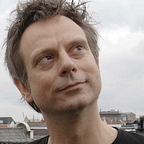New values in IoT at ThingsCon Amsterdam
Last week the third edition of ThingsCon Amsterdam took place in Volkshotel. As organiser the experience is always a bit blurred by all the last notice activities, but I was lucky to be part of a couple of sessions and see a lot of the talks. It turned out very well and I’m still chewing on the things that happened…
For me thinking on the Internet of Things is thinking on new possible meanings for both things as services. A new state of the thing, that adapts, have a dialogues with us as user and is able to play a role in our life on a different level. This is what I described before here on the principles of the connectable. It is also what the research of Nazli Cila is about, where I contribute to (a bit). She is looking into how products can be agents, take different roles towards the use and user, and other products. The product as a (passive) collector, as an actor or as a creator. These three levels of product agency have a personal and a societal impact. We need to think what is the level of delegation we give to these products. As Nazli put it:
The system must be adaptable to the different kind of user because each person may have different types of behaviour, characteristics, knowledge, skills and interest. Therefore, it is useful to design a system that is able to understand the type of user. There may be people with special skills and practices and they seeking assistance with their activities, someone who has a general knowledge and wants to improve his knowledge during the process or others who need a real support of help to make the activity easy and safe.
In the workshop on Thursday Nazli explored the principles with the different groups on a specific topic on design for people with dementia. This forces you to explore the concept of agency and delegation in-depth.
In another workshop on Friday Aduen Darriba Frederiks looked at the design for intimate interfaces, related to the new fashion tech that becomes more and more media for non screen interactions everywhere. How does this new garments influence our own feelings and behaviour. The designers from the Kimbow dress experiment with this on a conceptual level. I was not able to attend that session but it is a concrete installation of the new role of the physical-digital interaction-layer that will be present everywhere.
The adaptive dialogues with the products we use will be adaptive to the context of use. Value-exchange will be a leading principle, and it was good to have an workshop on the blockexchange to dive into the new tools for sharing value in the continuous connected presence. This can lead to new products like the self-sustaining bike-sharing concept that adapts to the state of product (bike) as much as that of the user. I had to miss the presentation on this in the Internet of Bikes session.
As we shift to these kind of products the influence of the design of the adaptive layer will impact our living even more. As we see that the technology not only deliver the happy flows it was very well present at this ThingsCon that we should discuss the design choice a level higher, to a more meta thinking on the role of this new technology in society. Max wrote a great piece on that already. Technology is not the start, but can play an important role to enable interactions within society and also can help to scale things.
It was maybe in that sense interesting that we moved a bit away from the pure thing at this year’s ThingsCon without losing sight of the role the thing plays as anchor point. We looked to the systematic impact more. The design angle is here important. What can we make from those new things with technology embedded to come to really new values. The complete merge of the physicality and the digital is an almost blank sleet to create new things, in that the maker culture in Shenzhen can inspire us. Where the ‘globalised mom and pop shop’ create a new collaborative model in making. It can us always inspire to ask the question to what level design is playing a role, and where functions emerge from use. Where participation is the approach to develop the meaningful things.
